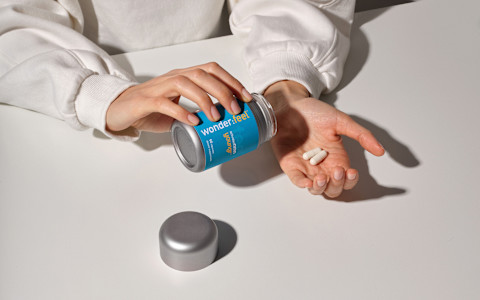Could Boosting This Molecule Be The Key To Slowing Aging?

When it comes to aging, we often focus on visible changes: wrinkles, fatigue, joint pain. But beneath the surface lies a powerful molecule called NAD, which plays a central role in nearly every function of the body.
As NAD levels decline with age, a cascade of changes begins, shifting how we look, feel, and function. This decline may be one of the most important biochemical drivers of aging itself.
On the mindbodygreen podcast, Andrew Salzman, M.D., a physician, biomedical entrepreneur, and Chief Medical Officer at Wonderfeel Biosciences, explains why NAD is a critical molecule for healthy aging and what we can do to support it.
With more than 30 years of experience in drug discovery, over 170 peer-reviewed papers, and 60 patents, Salzman is a leading voice in the science of cellular health and longevity. He’s also the mind behind Youngr™ NMN, Wonderfeel’s NAD-boosting supplement.
Understanding NAD: The body’s cellular powerhouse
NAD (nicotinamide adenine dinucleotide) is not just a buzzword; it’s essential to cellular energy production, metabolism, DNA repair, and overall function. Salzman describes it as the body’s “metabolic maestro,” coordinating how our systems perform and adapt to stress over time.
Unfortunately, NAD levels begin to decline in early adulthood. By age 40 or 50, they may drop significantly, and by the time you’re in your 60s, you could have half the NAD you had in your 20s. This drop correlates with many signs of aging, from slower metabolism to reduced muscle strength, cognitive decline, and hormonal shifts.
NAD’s central role in cellular repair and energy production means that its loss impacts almost every aspect of health.
How NAD decline affects the body
As NAD levels fall, we begin to see dysfunction across multiple systems:
Hormones & menopause
In women, one of the most profound impacts is on reproductive health. The drop in NAD contributes to decreased ovarian function1, which plays a central role in perimenopause and menopause.
As NAD declines, so does the energy available for supporting egg maturation and hormone regulation. This can lead to a cascade of symptoms, from irregular cycles and hot flashes to mood changes, brain fog, and disrupted sleep.
Muscle loss & physical performance
In men and women alike, declining NAD is tied to loss of muscle mass and strength. Muscle cells rely on NAD to fuel the mitochondria2 that power movement and endurance. As levels drop, so does our capacity to maintain lean muscle, contributing to frailty, slower recovery, and reduced athletic performance with age.
Sexual health
Sexual function also takes a hit. NAD supports blood flow, hormone synthesis, and mitochondrial health—all of which are essential for sexual vitality. Lower NAD3 levels can impact libido, arousal, erectile function4 in men, and vaginal health in women. While often overlooked, these changes are not just about intimacy; they’re a sign of broader systemic aging.
Additional impacts of low NAD
- Cognitive decline and memory issues
- Decreased skin elasticity and increased age spots
- Slower metabolism and weight gain
- Higher blood pressure and cardiovascular strain
Why NAD levels drop
So what causes NAD to drop in the first place? One major culprit is an enzyme called CD38. Salzman compares the body’s NAD balance to a bathtub: you need to keep the faucet running (NAD production), but also plug the drain (NAD loss). CD38 is that drain, an enzyme that breaks down NAD over time.
Levels of CD38 rise significantly with age, largely due to chronic, low-grade inflammation. Starting in your 20s, CD38 activity begins to increase and accelerates through midlife and beyond. This is part of why lifestyle factors like stress, poor diet, and lack of sleep (all known to increase inflammation) can further speed up aging at the cellular level.
How to support healthy NAD levels
While we can't stop NAD decline entirely, Salzman recommends a proactive approach to slow the process and restore balance:
Diet
A balanced diet rich in NAD precursors5, like tryptophan and niacin, is important. Foods such as broccoli, eggs, and fish contain these building blocks. However, Salzman notes that while diet helps, “the effect is rather small” on its own.
Exercise
Regular cardiovascular and resistance exercise helps stimulate NAD production in the mitochondria. By stressing muscle tissue in a healthy way, you encourage the body to generate more NAD naturally, which is particularly important for maintaining muscle mass and energy as you age.
NAD precursors
One of the most effective ways to increase NAD levels is through supplementation with precursors like NMN (nicotinamide mononucleotide). NMN6 is a direct precursor in the NAD synthesis pathway and can be quickly absorbed into cells to help replenish depleted stores. This targeted support is especially helpful as natural production slows with age.
Related read: Our favorite NAD supplements to support longevity

CD38 inhibitors
To address the “drain” of NAD, Salzman’s formula includes natural CD38 inhibitors like hydroxytyrosol (from olive oil) and resveratrol (found in red wine and grapes). These polyphenols may help reduce the breakdown of NAD, preserving more of what your body makes or the NAD taken from supplements.
The takeaway
The science of NAD offers a new lens through which to view aging, not as an inevitable decline, but as a biochemical process we can potentially influence
Whether you’re in your 30s and beginning to feel subtle changes or in your 60s and focused on maintaining vitality, supporting NAD may help slow cellular aging at its root. Salzman believes that targeting these molecular pathways represents a major shift, from treating the symptoms of aging to addressing its core mechanisms.
As research continues to evolve, NAD stands out as a key target for anyone looking to extend healthspan, improve daily performance, and age with strength and clarity.
6 Sources
- https://link.springer.com/article/10.1186/s12979-023-00398-w
- https://pubmed.ncbi.nlm.nih.gov/25308486/
- https://link.springer.com/article/10.1186/s12894-022-01107-3
- https://www.mdpi.com/1422-0067/26/7/3073
- https://link.springer.com/article/10.1007/s13668-023-00475-y#Sec3
- https://www.tandfonline.com/doi/abs/10.1080/07388551.2024.2433993
